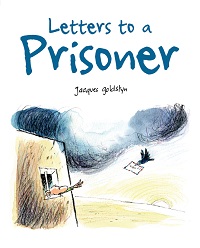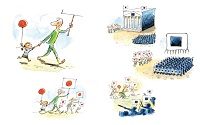| ________________
CM . . . . Volume XXIV Number 30. . . .April 6, 2018

 |
Letters to a Prisoner.
Jacques Goldstyn. Translated by Angela Keenlyside.
Toronto, ON: Owlkids Books, 2017.
42 pp., hardcover, $18.95.
ISBN 978-1-77147-251-7.
Subject Headings:
Stories without words.
Graphic novels.
Grades 2-5 / Ages 7-11.
Review by Christina Quintiliani
**** /4
|
| |
|

Letters to a Prisoner is a creative masterwork by Canadian author and illustrator Jacques Goldstyn. This gorgeous wordless picture book was inspired by Amnesty International’s “Write for Rights” campaign which supports individuals around the globe in writing and sending letters to those who have been wrongfully imprisoned. From the first page to the last, Letters to a Prisoner is a refreshing surprise as it seamlessly connects traditional picture book conventions with more modern, politically charged themes of social justice and freedom of speech.
 In this textless tale, a young girl and her father are seen attending a peaceful demonstration. Sadly, it is not long before troops disrupt the event and take the father away to be imprisoned for his involvement in the movement. Alone in his prison cell, the man is left to his thoughts which often drift to cherished memories of time spent with his daughter. Counting off days and drawing images on the prison walls help him pass time and bring comfort as he remains hopeful of one day being reunited with his daughter. On a day when he is particularly overcome with emotion and left in despair, a letter is suddenly delivered to him via a little bluebird who deposits it through the bars of the tiny overhead window of his cell. Unfortunately, it isn’t long before this most cherished surprise is seized by a prison guard and ripped to shreds before his eyes. However, much to his delight, more letters begin to arrive, but this time in multitudes. Enraged, the guard gathers them all up and instantly sends them to be burned. The drifting clouds of black smoke emanating from the prison ground extend across waters, scattering remnants of the letters back down to earth where they fall into the hands of hundreds of random individuals going about their daily lives. Inspired by what they have found, these individuals take the time to write their own letters of encouragement to the imprisoned man. With the assistance of neighbourhood birds, these letters are delivered en masse to the prison. It isn’t long before the letters mount up so high in the man’s prison cell that he is able to easily stand above the walls and escape to freedom on magical wings composed of the letters, themselves, which give him flight. Soaring into the sunset, the man returns home to experience the long awaited reunion with his daughter that had kept his hopes alive during the term of his imprisonment. The concluding illustration sees father and daughter sitting together at a desk, composing their own letters in hopes of delivering inspiration to other prisoners worldwide. In this textless tale, a young girl and her father are seen attending a peaceful demonstration. Sadly, it is not long before troops disrupt the event and take the father away to be imprisoned for his involvement in the movement. Alone in his prison cell, the man is left to his thoughts which often drift to cherished memories of time spent with his daughter. Counting off days and drawing images on the prison walls help him pass time and bring comfort as he remains hopeful of one day being reunited with his daughter. On a day when he is particularly overcome with emotion and left in despair, a letter is suddenly delivered to him via a little bluebird who deposits it through the bars of the tiny overhead window of his cell. Unfortunately, it isn’t long before this most cherished surprise is seized by a prison guard and ripped to shreds before his eyes. However, much to his delight, more letters begin to arrive, but this time in multitudes. Enraged, the guard gathers them all up and instantly sends them to be burned. The drifting clouds of black smoke emanating from the prison ground extend across waters, scattering remnants of the letters back down to earth where they fall into the hands of hundreds of random individuals going about their daily lives. Inspired by what they have found, these individuals take the time to write their own letters of encouragement to the imprisoned man. With the assistance of neighbourhood birds, these letters are delivered en masse to the prison. It isn’t long before the letters mount up so high in the man’s prison cell that he is able to easily stand above the walls and escape to freedom on magical wings composed of the letters, themselves, which give him flight. Soaring into the sunset, the man returns home to experience the long awaited reunion with his daughter that had kept his hopes alive during the term of his imprisonment. The concluding illustration sees father and daughter sitting together at a desk, composing their own letters in hopes of delivering inspiration to other prisoners worldwide.
Letters to a Prisoner is delightfully illustrated, and the lighthearted, cartoon like appearance of the characters makes for a pleasant contrast to the emotionally charged theme of the story. Goldstyn’s illustration placement is most effective, and the crafty mix of montages and single/double page spreads allows for easy movement of the eye from scene to scene. This format is unquestionably a huge plus for younger children in enhancing their comprehension of the story content and of plot sequencing. The book’s absence of text is undoubtedly one of the highlights of the story. The wordless actions and emotions exhibited by the characters in each illustration create a powerful, dynamic tone which would most likely be undermined through the addition of textual accompaniments.
Goldstyn’s work will engage a wide range of grade levels, with the uncluttered nature of the drawings appealing to younger readers and the advanced plotline attracting the appreciation of older audiences. Ideally, this book would serve as a valuable introduction to classroom lessons on freedom of speech and historical examples of those who have been wrongfully imprisoned in the quest to create positive change. A stunning wordless ode to those whose voices have been unjustly silenced, Letters to a Prisoner is a compelling reminder of the combined, collective strength of many, united in a single cause.
Highly Recommended.
Christina Quintiliani is an Ontario Certified Teacher and Ph.D. Candidate at the Faculty of Education, Brock University, St. Catharines, ON., where she is researching children’s literature.

To comment on this title or this review, send mail to cm@umanitoba.ca.
© CM Association
CC BY-NC-ND
Hosted by the University of Manitoba.
ISSN 1201-9364 |
This Creative Commons license allows you to download the review and share it with others as long as you credit the CM Association. You cannot change the review in any way or use it commercially.
Commercial use is available through a contract with the CM Association. This Creative Commons license allows publishers whose works are being reviewed to download and share said CM reviews provided you credit the CM Association. |
Next Review |
Table of Contents for This Issue
- April 6, 2018.
CM Home
| Back Issues
| Search
| CM Archive
| Profiles Archive
|

 In this textless tale, a young girl and her father are seen attending a peaceful demonstration. Sadly, it is not long before troops disrupt the event and take the father away to be imprisoned for his involvement in the movement. Alone in his prison cell, the man is left to his thoughts which often drift to cherished memories of time spent with his daughter. Counting off days and drawing images on the prison walls help him pass time and bring comfort as he remains hopeful of one day being reunited with his daughter. On a day when he is particularly overcome with emotion and left in despair, a letter is suddenly delivered to him via a little bluebird who deposits it through the bars of the tiny overhead window of his cell. Unfortunately, it isn’t long before this most cherished surprise is seized by a prison guard and ripped to shreds before his eyes. However, much to his delight, more letters begin to arrive, but this time in multitudes. Enraged, the guard gathers them all up and instantly sends them to be burned. The drifting clouds of black smoke emanating from the prison ground extend across waters, scattering remnants of the letters back down to earth where they fall into the hands of hundreds of random individuals going about their daily lives. Inspired by what they have found, these individuals take the time to write their own letters of encouragement to the imprisoned man. With the assistance of neighbourhood birds, these letters are delivered en masse to the prison. It isn’t long before the letters mount up so high in the man’s prison cell that he is able to easily stand above the walls and escape to freedom on magical wings composed of the letters, themselves, which give him flight. Soaring into the sunset, the man returns home to experience the long awaited reunion with his daughter that had kept his hopes alive during the term of his imprisonment. The concluding illustration sees father and daughter sitting together at a desk, composing their own letters in hopes of delivering inspiration to other prisoners worldwide.
In this textless tale, a young girl and her father are seen attending a peaceful demonstration. Sadly, it is not long before troops disrupt the event and take the father away to be imprisoned for his involvement in the movement. Alone in his prison cell, the man is left to his thoughts which often drift to cherished memories of time spent with his daughter. Counting off days and drawing images on the prison walls help him pass time and bring comfort as he remains hopeful of one day being reunited with his daughter. On a day when he is particularly overcome with emotion and left in despair, a letter is suddenly delivered to him via a little bluebird who deposits it through the bars of the tiny overhead window of his cell. Unfortunately, it isn’t long before this most cherished surprise is seized by a prison guard and ripped to shreds before his eyes. However, much to his delight, more letters begin to arrive, but this time in multitudes. Enraged, the guard gathers them all up and instantly sends them to be burned. The drifting clouds of black smoke emanating from the prison ground extend across waters, scattering remnants of the letters back down to earth where they fall into the hands of hundreds of random individuals going about their daily lives. Inspired by what they have found, these individuals take the time to write their own letters of encouragement to the imprisoned man. With the assistance of neighbourhood birds, these letters are delivered en masse to the prison. It isn’t long before the letters mount up so high in the man’s prison cell that he is able to easily stand above the walls and escape to freedom on magical wings composed of the letters, themselves, which give him flight. Soaring into the sunset, the man returns home to experience the long awaited reunion with his daughter that had kept his hopes alive during the term of his imprisonment. The concluding illustration sees father and daughter sitting together at a desk, composing their own letters in hopes of delivering inspiration to other prisoners worldwide.